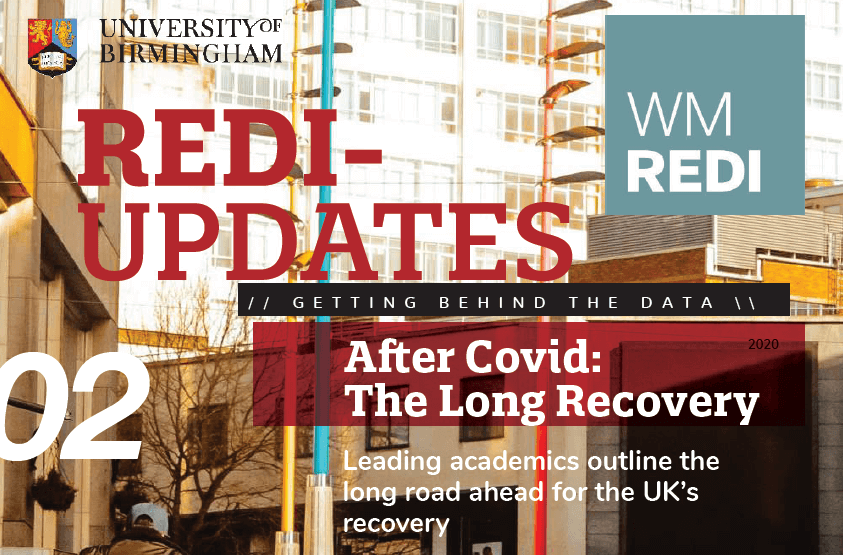 Welcome to REDI-Updates. REDI-Updates is a bi-annual publication which will get behind the data and translate it into understandable terms. In this edition, WM REDI staff and guest contributors will discuss some of the key topics when trying to understand the long-term economic impacts of the pandemic. In this article, Professor Anne Green looks at youth unemployment, why governments focus on young people when attempting to address worklessness, previous policies used to address this issue, and what the current government’s approach is during the COVID-19 pandemic.
Welcome to REDI-Updates. REDI-Updates is a bi-annual publication which will get behind the data and translate it into understandable terms. In this edition, WM REDI staff and guest contributors will discuss some of the key topics when trying to understand the long-term economic impacts of the pandemic. In this article, Professor Anne Green looks at youth unemployment, why governments focus on young people when attempting to address worklessness, previous policies used to address this issue, and what the current government’s approach is during the COVID-19 pandemic.
Why focus on young people?
Youth unemployment has a long-term impact on jobs, wages and well-being. The ‘scarring’ costs (Gregg, 2001; Speckesser and Kirchner Sala, 2015) of not addressing unemployment amongst young people merit the costs of a short-term response to a crisis.
It’s not new to have a focus on young people …
Over the last forty years, a range of mainstream national programmes have sought to support young people into work, alongside local initiatives. From the late 1970s to the mid-1990s the emphasis of youth employability programmes was on work experience and training, in the context of increases in welfare conditionality. This period saw the Youth Opportunities Programme (YOP) and the Youth Training Scheme (YTS), which dealt with increases in youth unemployment in the early 1980s recession. In 1998, a New Deal for Young People focused support on unemployed young people and in 2009 the Future Jobs Fund (FJF) was introduced to combat rising youth unemployment. The FJF created subsidised jobs in the public or third sector for longer-term young people. Subsequently, the FJF became part of the Young Person’s Guarantee, offering all longer-term unemployed 18-24 year olds a job, training or work experience. Then came the Youth Contract: a package of schemes aimed at helping young people into sustained employment, followed by the Youth Obligation. Simultaneously, other key thrusts of Government policy involve expansion of apprenticeships and traineeships as a means to address the transition to work for young people not taking the higher education route.

The demise of the youth labour market and more difficult transitions for disadvantaged young people
The last forty years have witnessed the decline of an identifiable youth labour market. Since the late 1970s, when the norm was entry to work straight from school, there have been ongoing marked sectoral shifts in the structure of employment and a rise in participation in post-compulsory education (Green, 2020). Alongside the shift from manufacturing to services, processes of professionalisation and polarisation in the labour market (Goos and Manning, 2007) have led to fewer labour market opportunities for disadvantaged young people, so making their transitions to work are more difficult. The proportion of young people combining learning and earning has declined over the last two decades (Conlan et al., 2015). Yet the emphasis placed by employers on work experience results in the ‘Catch-22’ situation for young people: they find it difficult to get a job without experience and without a job they find it difficult to get experience.
What is different in the Covid-19 crisis?
While it is not new for young people to bear the brunt of economic downturns, what is different about the Covid-19 crisis was the shutdown of sectors such as hospitality and non-food retailing which play an important role in facilitating labour market entry and gaining work experience for young people. Yet these sectors where young people are disproportionately concentrated are amongst those most severely hit by the immediate impacts of the Covid-19 lockdown. Analysis in April 2020 showed that employees aged under 25 years were about two and a half times as likely to work in a sector that was shut down as other employees (Joyce and Xu, 2020). At the same time closure of schools and other educational establishments impacted on learning, with associated concerns about the accentuation of existing socio-economic inequalities.
The newly unemployed and those facing long-term worklessness
Policies to tackle worklessness often distinguish between the newly unemployed and those facing long-term worklessness. At a time of crisis, attention tends to be focused on the newly unemployed and on efforts to stop the short-term unemployed becoming long-term unemployed. Yet young people facing multiple barriers to employment need support in entering and in sustaining employment regardless of the state of the national economy and the level of unemployment.
Policies focusing on the newly unemployed tend to take a ‘Work First’ approach, prioritising entry to work at the earliest opportunity. The emphasis of this approach is on job search assistance, short-term work preparation activity and targeted short-term work experience. By contrast, ‘Human Capital’ approaches seek to increase skills and qualifications to reduce the disadvantages that individuals face before assisting them to find work (Damm et al., 2020a).
Lessons from Talent Match
Of relevance for the second group, the final assessment of the £108million National Lottery-funded Talent Match programme, a five-year initiative to support England’s ‘hidden’ unemployed young people, was published in July 2020. Talent Match was a voluntary programme conceived and designed during a period of peak unemployment in the last recession. It aimed to support young people who were furthest from the labour market through personalised, non-standardised provision, incorporating some of the principles of the ‘Human Capital’ approach outlined above. Talent Match involved localised solutions inspired by involvement and co-design with young people and delivered on a ‘test and learn’ basis through partnership working and coordination at the local level under voluntary sector leadership.
Of the 25,885 young people supported by Talent Match, 11,940 (46 per cent) secured some form of job, including 4,479 (17 per cent) who secured sustained employment or self-employment. The evaluation showed high reported levels of job satisfaction, improved wellbeing and a positive social benefit with at least £3.08 of public value generated for every £1 spent on the programme (Damm et al., 2020b). Young people with multiple needs, often including mental health issues, will continue to face significant barriers in entering employment, and the danger is that they will be pushed back to the end of a long queue for jobs. Talent Match provides examples of how young people can be supported at a local level. It confirms that this support for some needs to be provided over the long term.
 Labour market policies to help young people in the Covid-19 crisis
Labour market policies to help young people in the Covid-19 crisis
In early July 2020, the Chancellor of the Exchequer set out a package of measures to help young people. The £2 billion Kickstart Scheme (building on evidence from FJF) will directly pay employers to create new jobs, with a minimum of 25 hours per week paid at least the National Minimum Wage, for 16 to 24 year-olds at risk of long-term unemployment. Kickstart jobs are due to last for six months. Another element of the support package for young people is a tripling of Traineeship places, designed to help young people into work. An employer will be paid £1,000 to take on a new trainee. For 18-19 year olds leaving school or college, the Government is providing £100 million to create more places on Level 2 and 3 courses, with particular emphasis on high demand sectors like engineering, construction and social care. There will also be an expansion of careers advice services.
Young people can also benefit from other new initiatives set out in the Plan for Jobs (HM Treasury, 2020). Here the expansion of sector-based work academies, providing training, work placements, and a guaranteed job interview in high-demand sectors, and of apprenticeships, is particularly relevant. Employers will be paid £2,000 for hiring a young apprentice and £1,500 for hiring apprentices aged 25 years and over.
At the time of writing, the Government has said little about the role for local authorities and their partners in co-ordinating the response locally. Yet devolution may offer the opportunity to build local employment support ecosystems which can help policies address particular local challenges and help provide a longer-term perspective than provided by short-lived initiatives.
Other age groups?
The focus on young people raises the question: ‘What about other groups?’ At the opposite end of the spectrum, the plight of older workers losing their jobs is a key concern, as they are at particular risk of suffering long-term unemployment (McIvor, 2020). The large cohort of people who were entering the labour market in the early 1980s recession might now be thinking about retirement. With increases in the state pension age, some people in the older age groups are looking to work for longer. Yet they are not – to date – the subject of tailored support.
This blog was written by Professor Anne Green, Professor of Regional Economic Development, City-REDI / WM REDI, University of Birmingham.
Disclaimer:
The views expressed in this analysis post are those of the authors and not necessarily those of City-REDI or the University of Birmingham.
